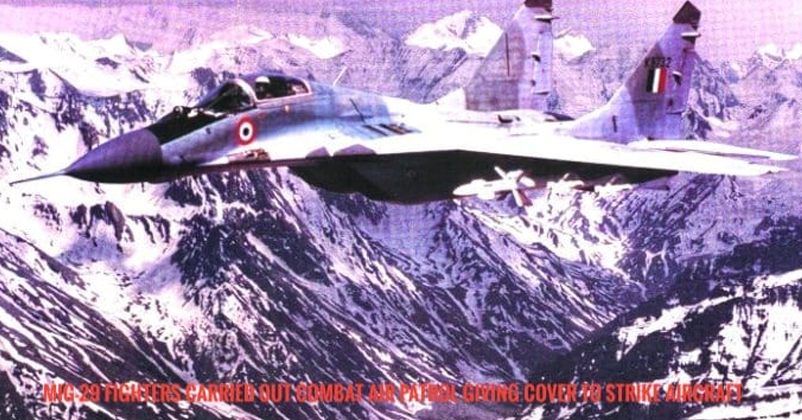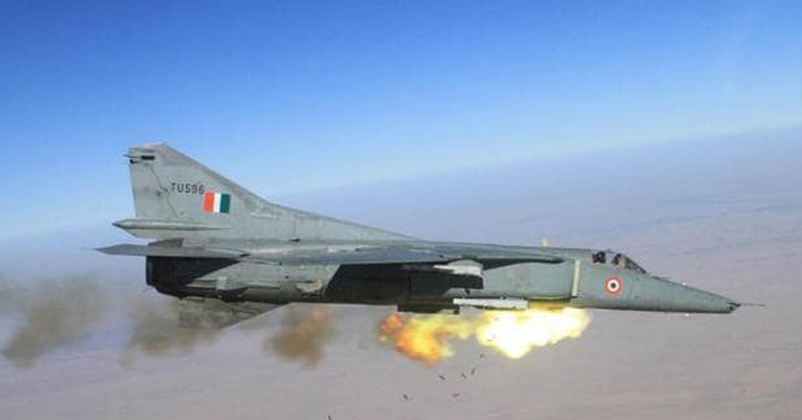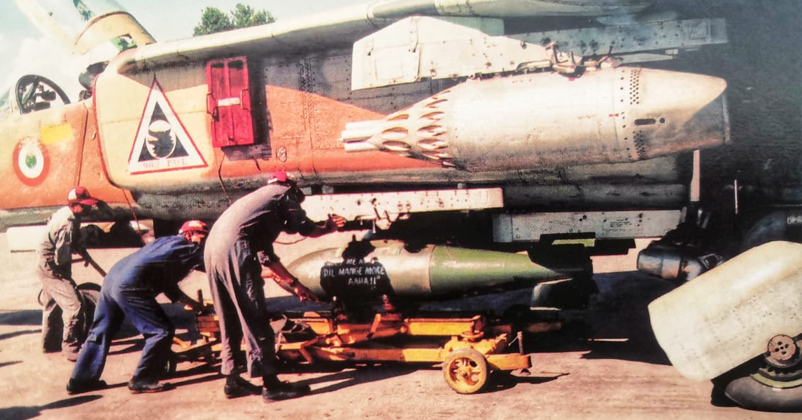The Summer Of 1999: Operation Safed Sagar; a turning point in the history of military aviation
| 26-May-2023 |

The IAF was first approached to provide air support on 11 May 99 with the use of helicopters. This was followed by a go ahead given on 25 May by the Cabinet Committee on Security (CCS) to the IAF to mount attacks on the infiltrators without crossing the LoC. While there was considerable pressure from outside the IAF to operate only attack helicopters, the CAS succeeded in convincing the Govt that in order to create a suitable environment for the helicopters, fighter action was required.
Operation Safedsagar, as the air operations in the Kargil area were called, was, indeed, a milestone in the history of military aviation, as this was the first time that air power was employed in such an environment.

Effect of Environment
High altitude operations always come with challenges like severe degradation of aircraft and weapon performance. At high altitudes, a crucial factor in aircraft performance is the reserve of power available, which, for the MiG and Mirage fleets, was a strong point in their favor.
Due to the very different attributes of the atmosphere, even weapons do not perform as per sea-level specifications. Variations in air temperature and density, altering drag indices and a host of other factors (which have never been calculated by any manufacturer for this type of altitude) cause weapons to go off their mark; for the same reasons, normally reliable computerised weapon aiming devices give inaccurate results.
In the plains, a 1000 pounder bomb landing 25 yards away from the target would still severely disable, if not flatten, it. In the mountains, however, a miss of a few yards would be as good as the proverbial mile, due to the undulating terrain and masking effects. In addition, due to the variation in elevation the "miss" would be greatly magnified in the linear dimension, further exaggerating the "inaccuracy" of the weapon/delivery. While this would lead to apparent inaccuracies in weapon delivery, there is, thus, a need for pinpoint accuracy in conditions where that very attribute is severely degraded by the factors mentioned above.
The First Few Days
The loss of one fighter and one Mi-17 chopper to enemy action indicated the need for a change of tactics, resulting in withdrawal of armed helicopters and employment of fighters in modified profiles out of the Stinger SAM envelope. By itself, the change of tactics is nothing unusual, and is an inherent part of the qualities of flexibility and adaptability; in fact, a far more serious lapse would be a dogged tendency to persist in sacrificing assets when, clearly, there was a need for a re-assessment. It is, perhaps for this reason that NATO, after deploying 100 Apache attack helicopters in Greece, reconsidered bringing them into Kosovo till the shooting was over, as they felt the environment didn't justify it. Unfortunately, IAF Mi-25/35 attack helicopters were not able to operate in this terrain.

One of the many facts that have emerged clearly is that target acquisition by the pilot is the bottom line. Totally unfamiliar surroundings in the Kargil area made target recognition difficult from the ground, let alone from a fast moving aircraft. As a result, the initial few sorties from high levels were not effective as desired. However, once revised and modified profiles, tactics and manner of system usage had been perfected, the accuracy of the airstrikes improved dramatically. Any time the target was spotted, a very high success rate invariably resulted.
Air Reconnaissance And Battle Damage Assessment : Crucial Aspects Of An Air War
The picture one normally associates with airstrikes emphasises helmeted pilots starting up their aircraft, flying to the target in the teeth of intense anti-aircraft fire and battling their way through hordes of enemy fighters to press home their attacks despite superhuman odds. In all fairness, that's the way it actually happened until the Second World War - the famous 1000 bomber raids over Germany, with the US 8th Air Force flying by day and the RAF by night, at a terrible cost in lives and machines.
Even at that time, though, the "back-room boys", that anonymous bunch of faceless experts who lived their lives poring over reconnaissance (recce) photographs, noting detail after painstaking detail, provided the target information that ultimately formed the basis of the bombing missions.
Three Main Steps in Neutralizing a Target
Far from being an off-the-cuff quick reaction affair, each airstrike is the end result of a carefully planned chain of events spanning several areas of specialisation. Broadly speaking, an airstrike would have the following components:-
(a) Recce mission(s).
(b) Airstrike mission(s).
(d) If so dictated by results of BDA, or by follow-up recce, repeated airstrikes.
The Increasing Effects of Airstrikes
As a result of these attacks, severe damage to enemy personnel and equipment became apparent in various areas. It is surmised that airstrikes contributed to a significant portion of the enemy's casualty list, as apparent in the numbers. However, the most telling effects on the ground were from intercepts of enemy radio revealing severe shortages of rations, water, medicines and ammunition. Losses due to airstrikes and inability to evacuate their casualties were also mentioned in the intercepts. This was the actual manifestation on the ground of the result of effective airstrikes by the IAF. The effect of accurate attacks is best summed up by a message received from one of the HQ of the Indian Army.......
"You guys have done a wonderful job. Your Mirage boys with their precision laser guided bombs targeted an enemy Battalion HQ in the Tiger Hill area with tremendous success. Five Pakistani officers were reported killed in that attack and their Command and Control broke down - as a result of which our troops have literally walked over the entire Tiger Hills area. The enemy is on the run. They are on the run in other sectors also. At this rate the end of the conflict may come soon."
IAF Air Strikes : the Results
IAF air strikes against enemy supply camps and other targets yielded rich dividends. A noteworthy fact is that there was not a single operation on ground that was not preceded by airstrikes, each and every one of which was the result of coordinated planning between 15 Corps and the AOC, J&K. However, one of the valuable lessons that emerged was the need for joint Army-Air Force planning and consultations from the very beginning, where the Air Force would be able to contribute by rendering advice on targeting which could, at the very outset, be incorporated into the Army plan of ground operations. This would prove far more effective than a case where the Army proceeded as per its own plans made earlier in isolation, and called for air support when they felt it was required.
Firstly, in the area of interdiction of enemy supplies, the successful and incessant attacks on the enemy's logistic machine had, over the last few weeks, culminated in a serious degradation of the enemy's ability to sustain himself in an increasing number of areas. The series of attacks against Pt 4388 in the Dras sector was an excellent example of how lethal airstrikes combined with timely reconnaissance detected the enemy plans to shift to alternate supply routes which were once again effectively attacked. In this the IAF succeeded in strangling the enemy supply arteries, amply testified to by enemy radio intercepts. The primacy of interdiction targets as opposed to Battlefield Air Strikes (BAS) targets was clearly brought out, as also the fact that air power is not to be frittered away on insignificant targets like machine gun posts and trenches, but on large targets of consequence (like the supply camp at Muntho Dhalo, enemy Battalion HQ on top of Tiger Hill, etc). Gone are the days of fighters screaming in at deck level, acting as a piece of extended artillery. The air defence environment of today's battlefield just does not permit such employment of airpower anymore, a significant fact that needs to be understood by soldier and civilian alike.
The second major impact of air power in this operation was in the area of casualties. Normally, an enemy defending a well fortified position (in this case, Pakistan) suffers between 3-6 times less casualties than does the force on the offensive. However, this operation has seen the reverse, with the enemy casualties far in excess of those suffered by us. One significant fact must not be lost sight of; of the two warring sides, it is the Pakistani Army that suffered air strikes, which, obviously, contributed significantly to its casualties. It is felt that without the use of air power, our own casualties could have approached if not exceeded four figures.
The third aspect is that of attack chopper operations. IAF dedicated attack choppers like the Mi-35 were incapable of operating at that altitude, which prompted the use of armed and modified Mi-17s for the role. Besides the capability of the machine itself vis-a-vis the area of operation, the creation of the right air defence environment is a crucial factor which would determine the employment of this platform. Effectiveness versus vulnerability would need to be examined; during Op Safedsagar, the abundance of man portable SAMs in all enemy-held areas precluded the effective employment of attack choppers. As a result, whether Army or IAF, choppers were constrained to operate in SAM-free areas. Nevertheless, IAF Cheetahs were instrumental in carrying out front line roles like providing a platform for the Airborne Forward Air Controller (FAC), a fighter pilot who guides the fighters in to the attack against ground targets.
The fourth major impact of air power is in the enormous difference it made to the ground operations, no better example of which exists than the message from the HQ of a field Army unit, (shown in italics above) stating that " as a result of the precision airstrikes on Tiger Hills our troops have literally walked over the entire Tiger Hills area. The enemy is on the run.."
Fifthly, night operations were carried out using ingenuity and imagination; at times, excellent results were achieved by aircraft like MiG-21s using little else but a stop watch and a GPS receiver. These operations had a significant effect on the enemy's resilience, stamina and very will to fight.
Sixthly, the effort put into air defence escorts and area Combat Air Patrolling by day as well as night proved an effective deterrent which ensured total air superiority. At times, PAF F-16s orbited a scant 15 kms (on their own side of the LOC) from our strike formations attacking Pakistani targets, kept at bay by our own air defence fighters flying a protective pattern above the strike.
The seventh aspect is the high degree of imagination, flexibility and IAF-Army coordination which marked every phase of the operation.
In the final analysis, the effective application of air power has indisputably saved further casualties as well as compressed considerably the timeframe in which our Army has made such progress on the ground. In this context, the basic functions of air power have been repeated, though on a much larger scale, when compared to the IAF's operations in this area during 1947-48, when IAF Tempests carried out strafing and rocket attacks on the intruders and Dakotas ferried in as well as paradropped troops and supplies. As then and now, when called upon by the nation the IAF has joined as an equal partner to the Army to meet the national objective.
Almost from the very beginning of the operations, IAF intellects were busy ticking over in a near constant brain-storming session aimed at deriving lessons from Operation Safedsagar. Being an ongoing process, the immense experience gained from this operation would stand in good stead in the times to come. These lessons would be applicable to all the world's Air Forces, for it is the first time in the history of military aviation that such an air operation took place in such an environment. While conventional long-accepted air power theories no longer held good, a new set of operating paradigms had to be evolved almost overnight to cope with the situation.
This is the first time the IAF fought a limited war, hitherto thought to be an unlikely eventuality, as air power and escalation to an all-out war were thought to be synonymous. The deterrent effect of air power has been enhanced by this fact, as the prospect of decisive air action is now a proven possibility in even a Low Intensity Conflict situation.
Operation Safed Sagar was, therefore, a turning point in the history of military aviation, and an operation that will, no doubt, be discussed and dissected for the next few years.
- Indian Air Force Archives
(c) Battle Damage Assessment (BDA) mission(s).